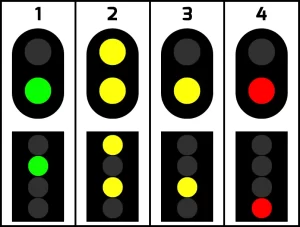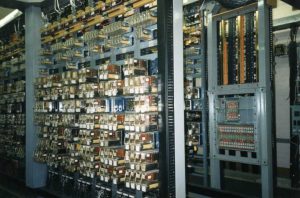The sprawling network of railways in the United Kingdom operates like a well-choreographed dance, allowing trains to traverse vast distances and connect communities efficiently. But have you ever wondered how this intricate system ensures the safety of passengers and cargo, preventing collisions and ensuring smooth operations? The answer lies in the ingenious design and operation of railway signals.
The Basics of UK Railway Signals
Railway signals are a critical aspect of the safe and efficient operation of train networks. They serve as a language that communicates essential information to train drivers, instructing them when to proceed, slow down, or stop. The signals are positioned alongside or above the tracks, providing visual cues that guide train operators through the complex web of tracks, junctions, and crossings.
Types of Signals

In the UK, railway signals can be classified into three primary categories: stop signals, distant signals, and speed signals.
- Stop Signals: These are the most critical signals. Their primary function is to convey to train drivers that they must come to a complete stop before proceeding. They are often located before junctions, stations, and potential hazards.
- Distant Signals: Distant signals provide drivers with advance notice of the state of upcoming stop signals. By indicating the status of the signals ahead, distant signals give train operators ample time to adjust their speed and prepare for potential stops.
- Speed Signals: These signals communicate the permitted speed for a specific section of track. They guide train operators on how fast they can safely travel, considering factors such as track conditions, gradients, and upcoming junctions.
Signaling Colors and Aspects
Railway signals use various colors and aspects (positions) to convey information to train drivers:
- Red: A red signal indicates a stop. Trains must come to a halt and remain stationary until the signal changes.
- Green: A green signal allows the train to proceed. It indicates that the route ahead is clear and safe.
- Yellow/Double Yellow: A yellow signal is a cautionary indication. It typically means that the next signal is displaying a red aspect, and the train must be prepared to stop. A double yellow indicates that the next signal is displaying a single yellow.
- Flashing Yellow: A flashing yellow aspect is used to indicate caution. It’s often found at diverging junctions or areas with reduced visibility.
- White: A white signal is used in conjunction with other signals. It often indicates a temporary or restricted speed limit in a specific section of track.
The Mechanics of Signaling
Behind the scenes, a complex interplay of technology and protocols ensures that signals function effectively. The heart of the signaling system is the interlocking system, which prevents conflicting movements of trains and ensures that routes are set only when they are safe.
Interlocking System
The interlocking system is a network of mechanical or electronic devices that prevents conflicting movements. It ensures that switches (points) and signals cannot be set in positions that would create unsafe conditions, such as two trains heading towards each other on the same track. Modern interlocking systems use computers and sensors to monitor the position of trains and switches, allowing for more precise control and real-time adjustments.

Track Circuits
To detect the presence of a train on a specific section of track, track circuits are employed. These circuits consist of an electrical current that flows through the rails. When a train enters the track circuit, it shunts the current, indicating its presence. This information is relayed to the signaling system, allowing it to control the signals accordingly.
Signaling Control Centers
Signaling control centers act as the nerve centers of the railway network. Skilled operators manage and monitor the signals, switches, and routes from these centers. They are equipped with advanced software that visualizes the entire rail network, allowing operators to respond swiftly to any anomalies, disruptions, or emergencies.
Signaling in Action
Imagine a scenario where a train is approaching a complex junction. The signaling system plays a critical role in coordinating the movement:
- As the train approaches the junction, distant signals inform the driver about the status of the upcoming stop signals.
- If the route is clear, the appropriate stop signals display a green aspect, indicating that the train can proceed through the junction.
- As the train continues its journey, speed signals provide guidance on permissible speeds, ensuring safe navigation.
- If the next section of track is occupied or if there’s a hazard ahead, the signaling system will display red or cautionary signals, prompting the driver to slow down or stop.
Evolving Signaling Technology
The world of railway signaling is not stagnant; it’s constantly evolving to enhance safety and efficiency. In recent years, technology advancements have introduced computer-based interlocking systems, digital signaling, and remote monitoring. These innovations allow for more precise control, faster response times, and increased flexibility in managing the network.
The Human Element
While technology plays a crucial role, the human element remains central to the safe operation of trains. Skilled signal operators, trained drivers, and maintenance personnel ensure that the signaling system functions optimally. Their expertise, combined with the technological infrastructure, forms a robust safety net for the entire railway network.
The intricate dance of trains along the UK railway network is made possible by the orchestration of signaling systems. These systems serve as the eyes and ears of the tracks, guiding trains safely through junctions, crossings, and stations. By providing drivers with vital information through a visual language of colors and aspects, railway signals ensure the smooth and secure operation of one of the most extensive and iconic railway networks in the world. As technology continues to advance, the future of railway signaling holds the promise of even greater safety and efficiency, building upon the legacy of innovation that has defined the UK’s railways for centuries.





